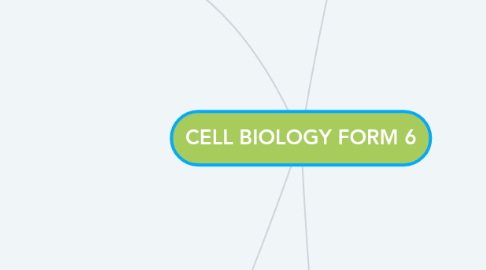
1. Topic 1.0 Biological molecules
1.1. Water
1.1.1. Learning outcome
1.1.1.1. Able to describe the chemical properties
1.1.1.1.1. Solvent
1.1.1.1.2. Bond angel
1.1.1.1.3. Hydrogen bond
1.1.1.2. Able to describe the physical properties
1.1.1.2.1. Polarity
1.1.1.2.2. Cohesiveness
1.1.1.2.3. Density
1.1.1.2.4. Surface tension
1.1.1.2.5. Specific heat capacity
1.1.1.2.6. Latent heat of vaporisation
1.2. Carbohydrate
1.2.1. Learning outcome
1.2.1.1. Able to classify carbohydrate into monosaccharide, dissaccharide, and polysaccharide with respect to their physical and chemical properties
1.2.1.2. Able to classify monosaccharide according to the number of carbon atom and the functional group
1.2.1.2.1. Triose
1.2.1.2.2. Pentose
1.2.1.2.3. Hexose
1.2.1.3. Able to describe the formation of glycosidic bond in disaccharides
1.2.1.3.1. maltose
1.2.1.3.2. sucrose
1.2.1.4. Able to illustrate the molecular structure of a monosaccharide and differentiate between the reducing and non-reducing ends.
1.2.1.5. Able the structure of disaccharides and polysaccharides to their functional in living organisms
1.3. Lipids
1.3.1. Learning outcomes
1.3.1.1. Able to describe the structure,properties and distribution of
1.3.1.1.1. triglyccrides
1.3.1.1.2. phospholipids
1.3.1.1.3. steroid
1.3.1.2. Able to state the function of
1.3.1.2.1. triglycerdes
1.3.1.2.2. phospholipids
1.3.1.2.3. steroid
1.3.1.3. Able to differentiate between
1.3.1.3.1. saturated fatty acids
1.3.1.3.2. unsaturated fatty acids
1.4. protien
1.4.1. Learning outcomes
1.4.1.1. Able to classify amino acid into four main classes based on their side chains: polar, non-polar acidic and basic.
1.4.1.2. Able to describe the structure of an amino acid and the formation of peptides bonds in polypeptides.
1.4.1.3. Able to explain the properties of protien
1.4.1.3.1. amphoteric
1.4.1.3.2. isoelectric point
1.4.1.3.3. buffer
1.4.1.3.4. colloid
1.4.1.4. Able to explain the denaturation and renaturation of protien
1.4.1.5. Able to classify proteins according to their
1.4.1.5.1. structure composition
1.4.1.5.2. functions
1.4.1.6. Able to differentiate the various level of organisation of proteins structure
1.4.1.6.1. primary
1.4.1.6.2. secondary
1.4.1.6.3. tertiary
1.4.1.6.4. quarternary
1.5. Nucleic acids
1.5.1. Learning outcomes
1.5.1.1. Able to describe the structure of nucleotides and the formation of phosphodiester bonds in a polynucleotoide
1.5.1.2. Able to distinguish between DNA and RNA and the three type of RNAs
1.5.1.2.1. mRNA
1.5.1.2.2. tRNA
1.5.1.2.3. rRNA
1.5.1.3. Able to describe the structure of DNA based on
1.5.1.3.1. Watson
1.5.1.3.2. Crick model
2. TOPICS 2.O Structure and eukaryotic
2.1. Eukaryotic cell
2.1.1. Learning outcomes
2.1.1.1. Able to state the cell theory
2.1.1.2. Able to compare the structure of eukaryotic cells
2.1.1.3. Able to compare typical animals as seen under electron microscopes
2.1.1.4. Able to describe the basic principles of light and electron microscopy
3. Topic 4.0 Photosynthesis
3.1. What is photosynthesis?
3.1.1. the process by which green plants and certain other organisms transform light energy into chemical energy.
3.2. Autotroph
3.2.1. Learning outcome
3.2.1.1. Able to classify autotroph into photoautotroph and chemoautotroph
3.2.1.2. Able to describe photosynthesis pigments
3.2.1.3. Able to explain the absorption spectrum and action spectrum of photosynthetic pigments
3.3. Light-dependent reaction
3.3.1. Learning outcome
3.3.1.1. Able to explain photo-activation of chlorophy a resulting in photolysis of water
3.3.1.2. Able to explain the cyclic and non cyclic photophosphorylation including electron transport system resulting in the production of ATP and NADPH
3.4. Light-independent reaction
3.4.1. Learning outcome
3.4.1.1. Able to describe Calvin cycle
3.4.1.2. Able to explain photorespiration
3.4.1.3. Able to describe the anatomical structure
3.4.1.4. Explain the carbon dioxide fixation
3.5. Limiting factor
3.5.1. Learning outcome
3.5.1.1. Able to explain limiting factor of photosynthesis
3.5.1.1.1. Light intensity
3.5.1.1.2. Carbon dioxide concentration
3.5.1.1.3. Temperature
4. Topic 3.0 Cellular respiration
4.1. The need for energy in living
4.1.1. Learning outcome
4.1.1.1. Able to outline the important of energy and respiration in living organism
4.1.1.2. Able to describe the structure of the energy carries such as ATP, NADH, and FADH
4.2. Aerobic respiration
4.2.1. Learning outcome
4.2.1.1. Able to describe the various stage of aerobic respiration and its location in the cells
4.2.1.2. Able to describe glycolysis and calculate the net energy produce in glycolysis
4.2.1.3. Able to describe the various step involved in the Krebs cycle
4.2.1.4. Able to explain the formation of NADH, FADH, GTP, and ATP during the Krebs cycle
4.3. Anaerobic respiration
4.3.1. Learning outcome
4.3.1.1. Able to explain the anaerobic respiration in yeast and muscle cell
4.3.1.2. Able to describe the application of anaerobic respiration in food industries
4.3.1.2.1. Bread
4.3.1.2.2. Tapai
4.3.1.2.3. Yogurt
